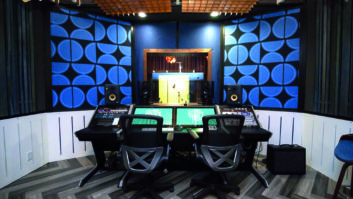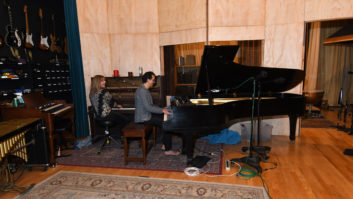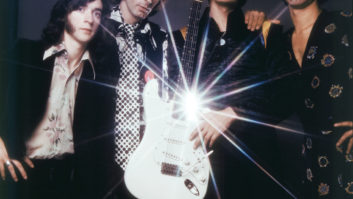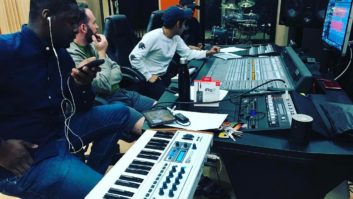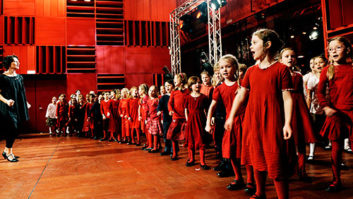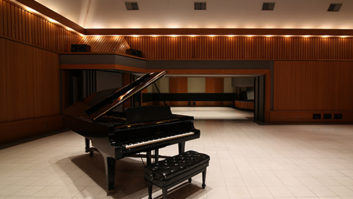“There’s gold in them thar’ tape vaults!”
Old and new bands alike are increasingly finding that the relatively low cost and high-profit margin of manufacturing CDs and marketing them primarily on the Internet is a good way to get music that might not ordinarily be heard out to their hardcore fan bases. In a sense, it’s easy money — but it’s also a godsend to fans to be able to tap into a mother lode of an artist’s previously unheard live or studio tapes…or at the very least, replace mediocre bootleg tapes/CDs with sonically superior, formally mastered CDs.
One of the most interesting recent examples in this area is Bright Midnight Records, an Internet-only venture by The Doors, whose career effectively ended when lead singer Jim Morrison died in Paris in 1971, but whose legacy still generates millions of dollars for the surviving former members. During Morrison’s lifetime, The Doors released only seven albums — six studio LPs and a live set — and in the three decades since his death, there have been only a few peeks into the band’s archives: a couple of authorized videos, a Morrison poetry album (American Prayer, which included some new music from the living Doors), a single live disc and 1997’s Doors box set, which included a live disc culled from three shows in New York in early 1970.
The interesting thing about surround sound is that there isn’t one way to go about handling it. Tricks may be fun to play with in your studio, but are they advancing the idea behind the music?
— Bob Clearmountain
The fact is, there aren’t a lot of live tapes of The Doors in circulation, because the band didn’t record their shows on a regular basis. There are some soundboard and monitor tapes in The Doors’ archives and, thanks to their fans, some bootleg audience tapes that have survived. But the best quality recordings The Doors have in their vault come from the winter 1970 tour (supporting Morrison Hotel) that became the basis for the double-LP Absolutely Live. These shows will be the heart of Bright Midnight’s ambitious release program: The company is committed to putting out three titles a year for the next six years — mostly complete, unedited concerts, remixed from the original 8-track masters by the man who originally recorded them, Bruce Botnick (who engineered all of The Doors’ studio albums, as well). They are being sold exclusively through the band’s official Web site, www.thedoors.com.
The first batch of three CDs (each is sold separately), which came out at the end of last year, is a little different than what will come out subsequently. It includes one full concert — a fascinating double-CD of an alternately rambling and explosive show from Cobo Arena in Detroit; a historic four-hour radio program, called No One Here Gets Out Alive, featuring extensive interviews and plenty of rare Doors music (it was put together 20 years ago by L.A. radio personality Jim Ladd to coincide with the release of the popular Danny Sugarman book of the same name); and a superb single-disc sampler showcasing tracks from some of the concerts that will be released on Bright Midnight, as well as a number of live rarities from other tape sources. It’s quite a bounty for Doors fans.
According to Botnick, “The philosophy behind this is to bring to the fans everything we’ve got on multitrack from that tour — the good, bad and the ugly. And there was some bad and ugly stuff in there. Not all concerts were great, of course. Sometimes Jim was inebriated, sometimes he wasn’t. A lot of it is really great, though, and deserves to be heard. We recorded everything on 8-track, and the goal now is to mix these shows as well as we can today and get them out there, because people have been listening to bootlegs that really sound lousy, and why should they have lousy in their house when they can have a lot better?”
Botnick says that the tapes were all in great shape. “They’re playing just fine, which I suppose is a testament to BASF,” he says. There was a problem to overcome on the Detroit tapes, however. “A person who previously worked on the tapes when I wasn’t around had pulled pieces out of the masters and they’re gone. So I had to go back to the live 2-tracks I had recorded at the same time to fill all the holes. It didn’t end up being too big of a problem.”
In the case of that May ’70 Cobo Arena show, Botnick was set up in a remote truck provided by Fedco Audio Labs, and he recorded the concert onto a Stevens solid-state, 1-inch 8-track and an Ampex 351 2-track. The truck was equipped with a custom console. Because The Doors were just three musicians and Morrison, he needed relatively few mics: AKG C-12As on guitarist Robbie Kreiger’s and keyboardist Ray Manzarek’s amps, and a Neumann U87 on Manzarek’s piano bass. John Densmore’s drums were captured by a Shure SM57 on the snare, an Altec “salt shaker” on the kick and Sennheiser 405s as overheads. Morrison sang into an SM57, and the audience was picked up by a Neumann SM69 stereo mic. The 8-track tape was BASF LR56 at 15 ips; the 2-track 3M 126. By today’s standards, that list probably looks downright primitive, but the fact is, the tapes sounded great.
Each of the live releases (with the exception of the sampler) has detailed technical information by Botnick, who notes, “I figure there are a lot of fans out there who want to know all that stuff. When I was growing up, I got a lot of my information from reading the back of albums. You’d occasionally find someone saying, ‘I used a U47 on the trumpets,’ so when I got to do recording, I sometimes tried the things I read about. So I’m continuing in that tradition.”
Botnick is mixing the tapes in his L.A.-area home studio, using a Sony DMX-R100 digital console as the heart of his system. Though the first concert set, Live in Detroit, was prepared at 48k, downsampled to 44.1 for CD (via db Technologies 3000s), Botnick has loftier intentions for other releases in the series: “The problem we have is that we’re still stuck in the CD area, so I can’t give everyone what it really sounds like because of the limitations of the CD. But all the future ones are going to be high-bandwidth — 96k, 24-bit — and will be 5.1 as well as stereo. And we’re hoping that we can release them in both SACD multichannel and DVD-A. I also really like the way DSD sounds. Those will all be much closer to the way it should sound.” Other equipment in Botnick’s arsenal for these CDs includes the new TC Electronic 6000 reverb, Ayre Acoustics V-1 amplifiers, db Technologies A/D converters, and an HD Sonic Solutions System for editing and mastering.
For Botnick, the project is both business and nostalgia. The Doors have been a major part of his livelihood since he was a teenager recording that first Doors album in early 1967. Every time he goes into the vault to listen to a studio or live multitrack — and there has been a plethora of hits and other releases over the years — he’s hearing himself at work as a young man. “In a way, when I’m mixing these tapes now, I’m trying to be 23 years old again,” he says with a chuckle. “And that’s hard. I’m not the same person today that I was in 1970. I have a different sensibility and obviously I’ve been listening to lots of different things through the years. Recording equipment has changed, of course. But what we’re trying to do [on these CDs] is capture the music as accurately as we can so we can bring the best to the fans. That’s really who it’s for.”
